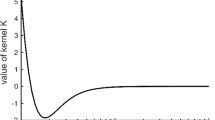Abstract
Spherical harmonic expansions of the geopotential are frequently used for modelling the earth’s gravity field. Degree and order of recently available models go up to 360, corresponding to a resolution of about50 km. Thus, the high degree potential coefficients can be verified nowadays even by locally distributed sets of terrestrial gravity anomalies. These verifications are important when combining the short wavelength model impact, e.g. for regional geoid determinations by means of collocation solutions. A method based on integral formulae is presented, enabling the improvement of geopotential models with respect to non-global distributed gravity anomalies. To illustrate the foregoing, geoid computations are carried out for the area of Iran, introducing theGPM2 geopotential model in combination with available regional gravity data. The accuracy of the geoid determination is estimated from a comparison with Doppler and levelling data to ±1.4m.
Similar content being viewed by others
References
C. BOUCHER, P. PAQUET and P. WILSON, 1981: Final Report of the Observations and Computations carried out in the Second European Doppler Observation Campaign (EDOC-2). Deutsche Geodätische Kommission, Reihe B, Nr. 255, Frankfurt am Main, 1981.
DEFENSE MAPPING AGENCY, 1979. Gravity Stations Data in the Area 25°–40° North and 43°–65° East. Aerospace Center, St. Louis Air Force Station, 1979.
G. DEHGHANI, 1981: Schwerefeld und Krustenaufbau im Iran. Hamburger Geophysikalische Einzelschriften, Reihe A, Heft 54, Hamburg, 1981.
D. LELGEMANN, 1983; Zur Glättung von Schwerefelddaten mittels Höhen- und Dichteinformationen. Zeitschrift für Vermessungswesen, 108. Jahrgang, S. 173–180, Stuttgart, 1983.
NATIONAL CARTOGRAPHIC CENTER OF IRAN, 1986a: 6′ × 7.5′ Mean Elevations for the Islamic Republic of Iran. Tehran, 1986.
NATIONAL CARTOGRAPHIC CENTER OF IRAN, 1986b: Doppler Derived Geoid Heights for the Islamic Republic of Iran. Personal communication with M. Hamesh, Tehran, 1986.
M.K. PAUL, 1978. Recurrence Relations for the Integrals of Associated Legendre Functions. Bulletin Géodésique, Volume 52, pp. 177–190, Paris, 1978.
R.H. RAPP, 1977: Potential Coefficient Determination from 5° Terrestrial Gravity Data. The Ohio State University, Department of Geodetic Science, Report No. 251, Columbus/Ohio, 1977.
R.H. RAPP, 1978: A Global 1°×1° Anomaly Field Combining Satellite, GEOS-3 Altimeter and Terrestrial Data. The Ohio State University, Department of Geodetic Science, Report No. 278, Columbus/Ohio, 1978.
M.G. SIDERIS and K.P. SCHWARZ, 1986; Improvements of Medium and Short Wavelength Features of Geopotential Solutions by Local Data. Proceedings of the International Symposium on the Definition of the Geoid, Florence 26–30 May 1986, pp. 561–576, Instituto Geografico Militare Italiano, Firenze, 1986.
L. SJÖBERG, 1980; A Recurrence Relation for the βℓ Function. Bulletin Géodésique, Volume 54, pp. 69–72, Paris, 1980.
L. SJÖBERG, 1984: Least Squares Modification of Stokes’ and Vening Meinesz’ Formulas by Accounting for Errors of Truncation, Potential Coefficients and Gravity Data. The Department of Geodesy Report No. 27, The University of Uppsala, Uppsala, 1984.
G.L. SWAIN, 1976: A Fortran IV Program for Interpolating irregulary spaced Data using the Difference Equations for Minimum Curvature. Computers and Geosciences, Vol. 1, No. 4, pp. 231–240, 1976.
C.C. TSCHERNING and R. FORSBERG, 1986: Geoid Determination in the Nordic Countries from Gravity and Height Data. Proceedings of the International Symposium on the Definition of the Geoid, Florence 26–30 May 1986, p. 325–350, Instituto Geografico Militare Italiano, Firenze, 1986.
G. WEBER, 1984: Hochauflösende mittlere Freiluftanomalien und gravimetrische Lotabweichungen für Europa. Wissenschaftliche Arbeiten der Fachrichtung Vermessungswesen der Universität Hannover, Nr. 135, Hannover, 1984.
H.-G. WENZEL, 1985: Hochauflösende Kugelfunktionsmodelle für das Gravitationspotential der Erde. Wissenschaftliche Arbeiten der Fachrichtung Vermessungswesen der Universität Hannover, Nr. 137, Hannover, 1985.
H. ZOMORRODIAN, 1987: The Establishment of the Iranian Gravity Datum (IG). Bureau Gravimétrique International, Bulletin d’Information, No. 60, Toulouse, 1987.
Author information
Authors and Affiliations
Rights and permissions
About this article
Cite this article
Weber, G., Zomorrodian, H. Regional geopotential model improvement for the Iranian geoid determination. Bull. Geodesique 62, 125–141 (1988). https://doi.org/10.1007/BF02519221
Received:
Accepted:
Issue Date:
DOI: https://doi.org/10.1007/BF02519221




